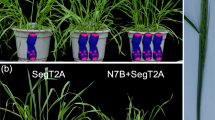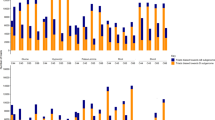Abstract
The merging of two different genomes occurs during the formation of amphidiploids, and the merged regulatory networks have the potential to generate a new gene expression pattern. We examined the genome-wide gene expression of two newly synthesized amphidiploids between Arabidopsis thaliana and the related species Arabidopsis lyrata subsp. lyrata and Arabidopsis halleri subsp. gemmifera. 1,137 (4.7%) and 1,316 (5.4%) of probesets showed differential gene expression in A. thaliana–A. halleri and A. thaliana–A. lyrata hybrids respectively, compared to the mid parent value and of these, 489 were in common. Genes that differed in expression between the parental lines tended to have an expression level in both hybrids differing from the mid parent value. In contrast to protein coding genes, there is little differential expression of transposons. Genes in the categories of chloroplast-targeted and response to stress were overrepresented in the non-additively expressed genes in both amphidiploids. As these genes have the potential to contribute directly to the plant phenotype, we suggest that rapid changes of gene expression in amphidiploids might be important for producing greater biomass.







Similar content being viewed by others
References
Adams KL, Percifield R, Wendel JF (2004) Organ-specific silencing of duplicated genes in a newly synthesized cotton allotetraploid. Genetics 168:2217–2226
Beaulieu J, Jean M, Belzile F (2009) The allotetraploid Arabidopsis thaliana–Arabidopsis lyrata subsp. petraea as an alternative model system for the study of polyploidy in plants. Mol Genet Genomics 281:421–435
Beck JB, Al-Shehbaz IA, O’Kane SL Jr, Schaal BA (2007) Further insights into the phylogeny of Arabidopsis (Brassicaceae) from nuclear Atmyb2 flanking sequence. Mol Phylogenet Evol 42:122–130
Berardini TZ, Mundodi S, Reiser L, Huala E, Garcia-Hernandez M, Zhang P, Mueller LA, Yoon J, Doyle A, Lander G, Moseyko N, Yoo D, Xu I, Zoeckler B, Montoya M, Miller N, Weems D, Rhee SY (2004) Functional annotation of the Arabidopsis genome using controlled vocabularies. Plant Physiol 135:745–755
Chen M, Ha M, Lackey E, Wang J, Chen ZJ (2008) RNAi of met1 reduces DNA methylation and induces genome-specific changes in gene expression and centromeric small RNA accumulation in Arabidopsis allopolyploids. Genetics 178:1845–1858
Comai L (2005) The advantages and disadvantages of being polyploid. Nat Rev Genet 6:836–846
Comai L, Tyagi AP, Winter K, Holmes-Davis R, Reynolds SH, Stevens Y, Byers B (2000) Phenotypic instability and rapid gene silencing in newly formed Arabidopsis allotetraploids. Plant Cell 12:1551–1568
Earley K, Lawrence RJ, Pontes O, Reuther R, Enciso AJ, Silva M, Neves N, Gross M, Viegas W, Pikaard CS (2006) Erasure of histone acetylation by Arabidopsis HDA6 mediates large-scale gene silencing in nucleolar dominance. Genes Dev 20:1283–1293
Flagel LE, Wendel JF (2010) Evolutionary rate variation, genomic dominance and duplicate gene expression evolution during allotetraploid cotton speciation. New Phytol 186:184–193
Flagel L, Udall J, Nettleton D, Wendel J (2008) Duplicate gene expression in allopolyploid Gossypium reveals two temporally distinct phases of expression evolution. BMC Biol 6:16
Fujimoto R, Sasaki T, Inoue H, Nishio T (2008a) Hypomethylation and transcriptional reactivation of retrotransposon-like sequences in ddm1 transgenic plants of Brassica rapa. Plant Mol Biol 66:463–473
Fujimoto R, Kinoshita Y, Kawabe A, Kinoshita T, Takashima K, Nordborg M, Nasrallah ME, Shimizu KK, Kudoh H, Kakutani T (2008b) Evolution and control of imprinted FWA genes in the genus Arabidopsis. PLoS Genet 4:e1000048
Fujimoto R, Sasaki T, Kudoh H, Taylor JM, Kakutani T, Dennis ES (2011) Epigenetic variation in the FWA gene within the genus Arabidopsis. Plant J 66:831–843
Gaeta RT, Pires JC, Iniguez-Luy F, Leon E, Osborn TC (2007) Genomic changes in resynthesized Brassica napus and their effect on gene expression and phenotype. Plant Cell 19:3403–3417
Gaeta RT, Yoo SY, Pires JC, Doerge RW, Chen ZJ, Osborn TC (2009) Analysis of gene expression in resynthesized Brassica napus allopolyploids using Arabidopsis 70mer oligo microarrays. PLoS One 4:e4760
Ha M, Kim ED, Chen ZJ (2009a) Duplicate genes increase expression diversity in closely related species and allopolyploids. Proc Natl Acad Sci USA 106:2295–2300
Ha M, Lu J, Tian L, Ramachandran V, Kasschau KD, Chapman EJ, Carrington JC, Chen X, Wang XJ, Chen ZJ (2009b) Small RNAs serve as a genetic buffer against genomic shock in Arabidopsis interspecific hybrids and allopolyploids. Proc Natl Acad Sci USA 106:17835–17840
He P, Friebe BR, Gill BS, Zhou JM (2003) Allopolyploidy alters gene expression in the highly stable hexaploid wheat. Plant Mol Biol 52:401–414
Hirochika H, Okamoto H, Kakutani T (2000) Silencing of retrotransposons in Arabidopsis and reactivation by the ddm1 mutation. Plant Cell 12:357–369
Irizarry RA, Hobbs B, Collin F, Beazer-Barclay YD, Antonellis KJ, Scherf U, Speed TP (2003a) Exploration, normalization, and summaries of high density oligonucleotide array probe level data. Biostatistics 4:249–264
Irizarry RA, Gautier L, Cope LM (2003b) The analysis of gene expression data: methods and software, chapter 4. Springer, Berlin
Johanson U, West J, Lister C, Michaels S, Amasino R, Dean C (2000) Molecular analysis of FRIGIDA, a major determinant of natural variation in Arabidopsis flowering time. Science 290:344–347
Kashkush K, Feldman M, Levy AA (2002) Gene loss, silencing and activation in a newly synthesized wheat allotetraploid. Genetics 160:1651–1659
Kashkush K, Feldman M, Levy AA (2003) Transcriptional activation of retrotransposons alters the expression of adjacent genes in wheat. Nat Genet 33:102–106
Kato M, Miura A, Bender J, Jacobsen SE, Kakutani T (2003) Role of CG and non-CG methylation in immobilization of transposons in Arabidopsis. Curr Biol 13:421–426
Koch MA, Haubold B, Mitchell-Olds T (2000) Comparative evolutionary analysis of chalcone synthase and alcohol dehydrogenase loci in Arabidopsis, Arabis, and related genera (Brassicaceae). Mol Biol Evol 17:1483–1498
Lawrence RJ, Earley K, Pontes O, Silva M, Chen ZJ, Neves N, Viegas W, Pikaard CS (2004) A concerted DNA methylation/histone methylation switch regulates rRNA gene dosage control and nucleolar dominance. Mol Cell 13:599–609
Lewis MS, Pikaard DJ, Nasrallah M, Doelling JH, Pikaard CS (2007) Locus-specific ribosomal RNA gene silencing in nucleolar dominance. PLoS One 2:e815
Lukens LN, Pires JC, Leon E, Vogelzang R, Oslach L, Osborn T (2006) Patterns of sequence loss and cytosine methylation within a population of newly resynthesized Brassica napus allopolyploids. Plant Physiol 140:336–348
Madlung A, Masuelli RW, Watson B, Reynolds SH, Davison J, Comai L (2002) Remodeling of DNA methylation and phenotypic and transcriptional changes in synthetic Arabidopsis allotetraploids. Plant Physiol 129:733–746
Madlung A, Tyagi AP, Watson B, Jiang H, Kagochi T, Doerge RW, Martienssen R, Comai L (2005) Genomic changes in synthetic Arabidopsis polyploids. Plant J 41:221–230
McClintock B (1984) The significance of responses of the genome to challenge. Science 226:792–801
Mirouze M, Reinders J, Bucher E, Nishimura T, Schneeberger K, Ossowski S, Cao J, Weigel D, Paszkowski J, Mathieu O (2009) Selective epigenetic control of retrotransposition in Arabidopsis. Nature 461:427–430
Miura A, Yonebayashi S, Watanabe K, Toyama T, Shimada H, Kakutani T (2001) Mobilization of transposons by a mutation abolishing full DNA methylation in Arabidopsis. Nature 411:212–214
Nasrallah ME, Yogeeswaran K, Snyder S, Nasrallah JB (2000) Arabidopsis species hybrids in the study of species differences and evolution of amphiploidy in plants. Plant Physiol 124:1605–1614
Nasrallah JB, Liu P, Sherman-Broyles S, Schmidt R, Nasrallah ME (2007) Epigenetic mechanisms for breakdown of self-incompatibility in interspecific hybrids. Genetics 175:1965–1973
Ni Z, Kim ED, Ha M, Lackey E, Liu J, Zhang Y, Sun Q, Chen ZJ (2009) Altered circadian rhythms regulate growth vigour in hybrids and allopolyploids. Nature 457:327–331
Parisod C, Alix K, Just J, Petit M, Sarilar V, Mhiri C, Ainouche M, Chalhoub B, Glandbastien MA (2010) Impact of transposable elements on the organization and function of allopolyploid genomes. New Phytol 186:37–45
Preuss SB, Costa-Nunes P, Tucker S, Pontes O, Lawrence RJ, Mosher R, Kasschau KD, Carrington JC, Baulcombe DC, Viegas W, Pikaard CS (2008) Multimegabase silencing in nucleolar dominance involves siRNA-directed DNA methylation and specific methylcytosine-binding proteins. Mol Cell 32:673–684
Pumphrey M, Bai J, Laudencia-Chingcuanco D, Anderson O, Gill BS (2009) Nonadditive expression of homoeologous genes is established upon polyploidization in hexaploid wheat. Genetics 181:1147–1157
Rapp RA, Udall JA, Wendel JF (2009) Genomic expression dominance in allopolyploids. BMC Biol 7:18
Singer T, Yordan C, Martienssen RA (2001) Robertson’s Mutator transposons in A. thaliana are regulated by the chromatin-remodeling gene Decrease in DNA Methylation (DDM1). Genes Dev 15:591–602
Slotkin RK, Vaughn M, Borges F, Tanurdzić M, Becker JD, Feijó JA, Martienssen RA (2009) Epigenetic reprogramming and small RNA silencing of transposable elements in pollen. Cell 136:461–472
Tsukahara S, Kobayashi A, Kawabe A, Mathieu O, Miura A, Kakutani T (2009) Bursts of retrotransposition reproduced in Arabidopsis. Nature 461:423–426
Wang J, Tian L, Lee HS, Wei NE, Jiang H, Watson B, Madlung A, Osborn TC, Doerge RW, Comai L, Chen ZJ (2006a) Genomewide nonadditive gene regulation in Arabidopsis allotetraploids. Genetics 172:507–517
Wang J, Tian L, Lee HS, Chen ZJ (2006b) Nonadditive regulation of FRI and FLC loci mediates flowering-time variation in Arabidopsis allopolyploids. Genetics 173:965–974
Acknowledgments
We thank Dr. Tetsuji Kakutani because this work originally started in his laboratory at National Institute of Genetics. We thank Dr. Candice Sheldon and Dr. Michael Groszmann for critical comments on the manuscript and Dr. Masahiro Fujita for his technical advice. This work is supported by Research Fellowship of the Japan Society for the Promotion of Science (JSPS) for Young Scientists and Excellent Young Researcher Overseas Visit Program of the JSPS to R. Fujimoto.
Author information
Authors and Affiliations
Corresponding author
Additional information
Microarray data have been deposited with GEO under GSE23318.
Electronic supplementary material
Below is the link to the electronic supplementary material.
11103_2011_9820_MOESM1_ESM.ppt
Figure S1. Scatter plot of relative signal intensity. Relative signal intensity of each spot from 6 experiments was plotted. Two lines, #39-1 and #39-2, of the artificially synthesized amphidiploid between A. thaliana and A. halleri had highly correlated expression levels (shown in bold letters). Two lines, #77-1 and #77-2, of the artificially synthesized amphidiploid between A. thaliana and A. lyrata also had highly correlated expression levels (shown in bold letters). At–Al Hyb, hybrid between A. thaliana and A. lyrata; At–Ah Hyb, hybrid between A. thaliana and A. halleri. MPV At–Ah, mid parent value between A. thaliana and A. halleri; MPV At–Al, mid parent value between A. thaliana and A. lyrata; r, correlation coefficient. Supplementary material 1 (PPT 195 kb)
11103_2011_9820_MOESM2_ESM.ppt
Figure S2. GO classification. The ratio of the up- and down- regulated genes in At–Al hybrid detected by perfect match probeset. The relative ratios were calculated by dividing the percentage of all annotated genes in A. thaliana. Supplementary material 2 (PPT 88 kb)
11103_2011_9820_MOESM3_ESM.ppt
Figure S3. Verification of four transposons detected in microarrays (Array data) by RT-PCR. At, A. thaliana; Al, A. lyrata; Ah, A. halleri; AtAl, hybrid between A. thaliana and A. lyrata; AtAh, hybrid between A. thaliana, and A. halleri. Right panels are the results of PCR using genomic DNA as a template. Supplementary material 3 (PPT 103 kb)
Rights and permissions
About this article
Cite this article
Fujimoto, R., Taylor, J.M., Sasaki, T. et al. Genome wide gene expression in artificially synthesized amphidiploids of Arabidopsis . Plant Mol Biol 77, 419 (2011). https://doi.org/10.1007/s11103-011-9820-y
Received:
Accepted:
Published:
DOI: https://doi.org/10.1007/s11103-011-9820-y




